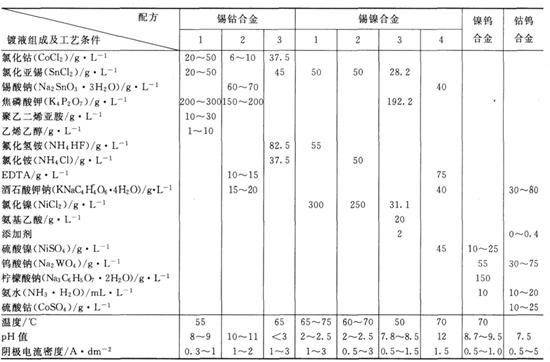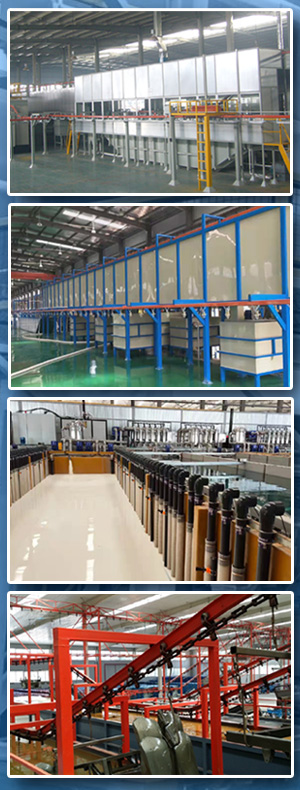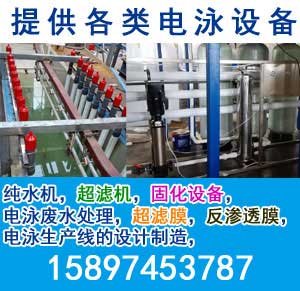电泳技术
分享电泳设备设计制造服务及电泳漆技术咨询
-
Anodic Versus Cathodic 阳极沉积法和阴极沉积法的区别
Based upon the method of deposition, two types of electropaint have been developed: anodic and cathodic. The anodic types were commercialized first for two reasons:
基于沉积的电泳方式,已经开发了阳极电泳漆和阴极电泳漆两种类型的电泳漆阳极电泳漆首先投入正式生产有两个原因: The earlier resin technology was based on resins which contained acid groups. These could be neutralized to allow them to become soluble in water. 早期的树脂制造技术都是以含酸基团的树脂为基础,中和后,他们可以溶于水。 When the solubilized resin was deposited, it regained its acidic function. This acidity permits ready crosslinking (curing) when the coating is baked. 当水溶性树脂沉积后,它可以恢复其酸性基团的功能。当此涂层被烘干时,这种酸性基团可使漆膜其迅速交联(固化)。 The ability to produce a cathodic-type resin was available long before the resins were introduced commercially in 1975. Two major problems had to be overcome before commercialization became possible: 阴极电泳漆的树脂在1975年阳极型树脂商品化之前很长一段时间内就有能力制造了,但其正式投产之前要克服以下两个主要的问题。 A method was needed to make alkaline polymers cure at temperatures low enough to ensure body integrity. 降低碱性聚合物固化的温度,同时还要确保漆膜的均一性。 The corrosivity of the bath solution had to be reduced. 必须降低槽液的腐蚀性。 The process of curing thermosetting resins is called "crosslinking". During this process, which is driven by heat, the relatively small molecules deposited are chemically intertwined to form a single uniform film. 热固型树脂的固化过程称为交联, 这个过程是以热为动力,较小分子的沉积膜经化学交联形成一个完整的表面。. The reactions involved in crosslinking deposited film depend upon the film's chemical environment. The structures that are obtained by these curing reactions are essential for the practical value of the coating. Reaction conditions also determine bake time, temperature and, therefore, energy consumption. 电泳漆膜交联的反应取决于涂膜的化学反应环境,靠这些固化反应获得的涂膜结构,对其防腐性能]具有真正的实际价值。反应的条件也决定了烘干时间及温度,以及消耗能源。 Anodic electrocoats usually have a pH of approximately 9.0; however, the deposited film is, in contrast, highly acidic. Acid catalyzed crosslinking reactions can be used with little difficulty. 阳极电泳槽液一般pH约为9,可沉积涂层却是高酸性。酸催化的交联反应比较容易进行。 The situation is somewhat different for cathodic materials. As with anodic resins, the crosslinking can be either internal or external. Because of the alkaline nature of the uncured cationic film, external linking reactions are sluggish. 对阴极电泳就有所不同了,阳离子树脂的交联反应可以在内部或外部进行,但因未固化阴离子涂膜具有碱性,所以外部交联反应较缓慢。 Internal crosslinking is carried out by urethane groups mixed with the cathodic resin. These crosslinkers are stable in water at normal bath temperature but become reactive at curing temperatures. Special procedures are used to ensure that these crosslinkers will not react at bath temperature to cause instability. 内部的交联是靠与阳离子树脂混合的氨基甲酸脂基团进行的。这些交联剂于正常槽液温度下在水中很稳定,但在固化温度下就变得活泼起来。通过采用一些特殊的处理工艺,确保这些交联剂不会在槽液温度起反应而引起槽液的不稳定性。 Although numerous types of resins may be suitable for electrodeposition, the most common ones are thermosetting. Thermosetting resins fuse or melt when baked into a hard, uniform, solvent-resistant film. 虽然多种树脂都可以适用于电泳涂装,但最常见的是热固型的 热固型的树脂在烘干时融合或融化成为一坚硬,均匀的耐溶剂涂膜。 Resin chemists must ensure that the resin has particular properties of hardness, flexibility, adhesion, water-and-chemical resistance, pigment wetting, and others. To be used as an electropaint, the resin must also have the following characteristics: 研发人员必须确保树脂具有硬度,柔韧性,附着力,耐水及化学品性,颜料湿润性及其它特性。用于制造电泳漆的树脂还必须具备如下特性: It must be soluble or dispersible to form a stable solution even when subjected to a wide variety of production conditions. 树脂必须可溶解或分散成一种稳定的溶液,可以适应多种生产条件。 It must deposit onto an electrode to form a smooth, dense, insulating, wet film which also contains pigment. 树脂必须能沉积在一个电极上,形成一光滑,致密,绝缘,并含有颜料的湿涂膜。 It must be able to coat a part which is complex in shape. 必须能够泳涂外形复杂的工件。 It must resist re-dissolution when rinsed. 必须在冲洗时不再被溶解掉。 It must become mechanically and chemically stable upon baking so that the resulting film can fulfill its protective and/or decorative requirements. 经烘干后的涂膜具有机械及化学稳定性,以满足保护和(或)装饰的需要。 Although the principle of electrodeposition gained acceptance with the anodic systems, it was not until the cathodic method was developed that electrodeposition became the common method for priming automobiles. The cathodic method has the following advantages: 虽然电泳涂装的原理是从阳极电泳系统获得的, 但是直到开发出了阴极电泳涂装法以后, 电泳涂装才成为汽车涂底漆普遍采用的方法。阴极电泳漆有以下优点: It achieves corrosion resistance at low film thickness. 较低的膜厚具有良好的防腐蚀性。 It permits throwpower to interior surfaces without penalty of over-build on exterior surfaces. 保证工件内表面泳透力的同时,外表面上涂膜也不会过厚。 It achieves bimetallic joint corrosion resistance required by the increased use of galvanized metal. 双金属复合层也能获得良好的防腐蚀性, 可适应日益扩大的镀锌钢板用量的需求。 It possesses saponification resistance and long-term adhesion retention over an entire galvanized body panel. 它具有耐皂化性, 在全镀锌的车身板上可长期保持其附着力。 It requires substantially less electrical consumption for deposition and, as a result, less refrigeration for cooling. 电泳本身耗电量少,从而用于冷却的冷量也少。 It achieves gloss and hold-out with and without spray primers. 本身具有足够的光泽度,可喷涂或不喷涂中涂, 同时在没有中涂的情况下也不影响面漆的亮度。 The prime advantage for cathodic systems, however, is superior corrosion protection. With anodic electrodeposition, metallic ions from the part being coated often become included in the deposited film. This condition results from anode reactions when current is applied. The presence of the iron ion in the film provides a readily available site for rust to start. In addition, when deposited, cationic resins are alkaline in nature and tend to be natural corrosion inhibitors. 其实, 阴极电泳的最主要优点还是防腐蚀性非常优良。材用阳极电泳时,由于通电时的阳极反应从被涂工件上溶下的金属离子常常包含在漆膜中,。在漆膜中存在的铁离子就成了开始生锈的诱因。另外,沉积时,阳粒子树脂呈碱性, 这样就成为天然的缓蚀剂。本公司可以承接电泳生产线和各类涂装生产线设计、制造、施工,为您提供一流的涂装生产线生产制造服务,让您更省时、省力、省心。全国服务热线:15897453787
-
阳极沉积法和阴极沉积法的区别
1477 人参与 2011年11月21日 00:57 分类 : 电泳工艺 电泳原理 评论
-

前面已经介绍过,电泳涂装技术的应用源自汽车工业。现已经历了40多年的历程,在其他工业领域也应用十分广泛。根据产品的不同需求,需要采用不同种类的电泳涂料满足其需求。表5-1列举了电泳涂料在一些工业方面的应用。表5-1电泳涂料的工业应用领域
-

猫眼石又称“猫眼”、“描儿眼”、“波光石”或“变石”。因主要是这种宝石中有一条闪光亮泽,且能因光线变化而变化,酷似猫的眼睛。故称“猫眼石”。猫眼石十分的珍贵,下面我们就来分享一下猫眼石如何鉴别以及猫眼石的品牌。猫眼石是一种具有神奇的色彩和迷人的光带的天然宝石,
-

今天小编为大家分享的是关于静电热喷涂法原理的文章,有关注的朋友一起来看看吧。静电热喷涂工艺主要用于重防腐粉末涂装,它可在较短时间内涂覆300μm以上的厚涂膜。下面介绍钢管内外表面同时静电热喷涂粉末的工艺过程(图21)。静电热喷涂生产线可以喷涂直径Φ11
-

镀铬层硬度高、镀层经久不变色,因而广泛地用作装饰性镀层的最终镀层;其缺点是电流效率低、分散能力差,尤其是该工艺对环境污染严重,因而有些国家已明令禁止,不能再采用镀铬工艺。在已报道的代铬技术中,从覆盖层的性质上可分为合金镀层、金属一非金属,复合层、无机代铬层和
电泳设备
-


最近发表
技术咨询
